Gary Allen's Blog, page 15
February 15, 2016
Food Sites for March 2016

Hama Hama oysters, from Washington’s Hood Canal, just one of the good reasons to invite ice indoors.
(This is still one of the months with an R in it—even if that old rule no longer applies—and oysters are always welcome around here.)
The last full month of winter is about to end (and not a minute too soon if you ask us). With March, we hope to see signs of Spring’s approach—which is not always a sure thing, no matter what the calendar says. Meanwhile, boeuf bourguignon and such-like slow-cooked dishes provide a good excuse to avoid going out in the cold.
Regular subscribers to our updates newsletter receive these updates from our blog, Just Served, directly—but there is much more at the blog that isn’t delivered automatically. February has been rather hectic around here, plus I’m starting work on another book, so no new stories have been posted... but Modern Salt will put up two—that haven’t been seen in a long time—in March. The first will appear on March second, and the other a few weeks later. You’ve been warned.
You can, if you wish, follow us on Facebook, and Twitter. Still more of our online scribbles can be found at A Quiet Little Table in the Corner.
This month’s quotes (from On the Table’s culinary quote collection) indulge, literarily, our love for Crassostrea gigas:
If you don’t love life you can’t enjoy an oyster; there is a shock of freshness to it and intimations of the ages of man, some piercing intuition of the sea and all its weeds and breezes. Eleanor Clark
I asked the waiter for a dozen Portugaises and a half-carafe of the dry white wine they had there ... As I ate the oysters with their strong taste of the sea and their faint metallic taste that the cold white wine washed away, leaving only the sea taste and the succulent texture, and as I drank their cold liquid from each shell and washed it down with the crisp taste of the wine, I ... began to be happy and to make plans. Ernest Hemingway
I am ready to defend the right of the tasty crab, the luscious oyster, the noble rockfish and the incomparable terrapin to continue their part in the penitential practice of Friday. Lawrence Cardinal Shehan, Archbishop of Baltimore
You are eating the sea, that’s it, only the sensation of a gulp of seawater has been wafted out of it by some sorcery, and are on the verge of remembering you don’t know what, mermaids or the sudden smell of kelp on the ebb tide or a poem you read once, something connected with the flavor of life itself. Eleanor Clark (on oysters)
It is proved by experience that, beyond five or six dozen, oysters certainly cease to be enjoyable. Grimod de la Reyniere
Oyster: A slimy, gobby shellfish which civilization gives men the hardihood to eat without removing its entrails. The shells are something given to the poor. Ambrose BierceGaryMarch, 2016
PS: If you encounter broken links, changed URLs—or know of wonderful sites we’ve missed—please drop us a line. It helps to keep this resource as useful as possible for all of us. To those of you who have introduced us to sites like the ones in this newsletter (such as Jim Chevallier), thanks, and keep them coming!
PPS: If you wish to change the e-mail address at which you receive these newsletters, or otherwise modify the way you receive our postings or—if you’ve received this newsletter by mistake, and/or don’t wish to receive future issues—you have our sincere apology and can have your e-mail address deleted from the list immediately. We’re happy (and continuously amazed) that so few people have decided to leave the list but, should you choose to be one of them, let us know and we’ll see that your in-box is never afflicted by these updates again. You’ll find links at the bottom of this page to fix everything to your liking.
---- the new sites ----
Brief History of Confit, A(Jonell Galloway on the various ways the French preserve, and intensify, the flavors of foods)
George Washington, the Whiskey Baron of Mount Vernon(Michael Beschloss, in The New York Times, on the first president’s second career)
Love Letter to Greenwich Village(Ruth Reichl waxes nostalgic while reading an unusual community cookbook)
Oaxaca’s Native Maize Embraced by Top Chefs in U.S. and Europe(the old ways may not fare well against modern agriculture, but they often lead to much tastier food)
Old Regime Cheese(Les Leftovers serves up part 1 of “the lost cheeses of Medieval France;” part 2, “What, no Camembert?” )
No Food is “Healthy”(Michael Ruhlman on why “American food shoppers are confused”)
Viking Foods(detailed overview, replete with recipes and bibliography)
What Gives Jasmine and Basmati Rice Their Fragrance?(Hint: it has something to do with pandan)
Why the Best Part of a Pot of Rice is at the Bottom(the article doesn’t actually answer the question, but provides links to recipes that produce that crunchy layer)
---- inspirational (or otherwise useful) site for writers/bloggers ----
7 Mistakes You’re Making With Your Author Blog And How To Fix Them
Do the Copyright Thing: Your Use of Origin Images to Sell Coffee May Be Unlawful
---- more blogs ----
Bites of Food History
Eat Something Sexy
How to be the Hero of Your Own Kitchen!
---- that’s all for now ----
Except, of course, for the usual legalistic mumbo-jumbo and commercial flim-flam:
Your privacy is important to us. We will not give, sell or share your e-mail address with anyone, for any purpose—ever. Nonetheless, we will expose you to the following irredeemably brazen plugs:
Want to support On the Table, without spending a dime of your own money on it?
It’s easy. Whenever you want to shop on Amazon. Com, click on any of the book links below, then whatever you buy there will earn a commission for this newsletter (it doesn’t even have to be one of our books).
The Resource Guide for Food Writers
(Paper)(Kindle)Our Food Sites newsletters merely update the contents of this book; what doesn't appear here is already in the book.
The Herbalist in the Kitchen
(Hardcover)
(Kindle)
The Business of Food: Encyclopedia of the Food And Drink Industries
(Hardcover)(Kindle)
Human Cuisine
(Paper)(Kindle)
Herbs: A Global History
(Hardcover)(Kindle)
Sausage: A Global History
(Hardcover)(Kindle)
Can It! The Perils and Pleasures of Preserving Foods (pre-order)(Hardcover)
Terms of Vegery
(Kindle)
How to Serve Man: On Cannibalism, Sex, Sacrifice, & the Nature of Eating
(Kindle)
Here endeth the sales pitch(es)...
...for the moment, anyway.
______________
"The Resource Guide for Food Writers, Update #185" is protected by copyright, and is provided at no cost, for your personal use only. It may not be copied or retransmitted unless this notice remains affixed. Any other form of republication—unless with the author‘s prior written permission—is strictly prohibited.
Copyright (c) 2016 by Gary Allen.
Published on February 15, 2016 09:20
January 20, 2016
Food Sites for February 2016
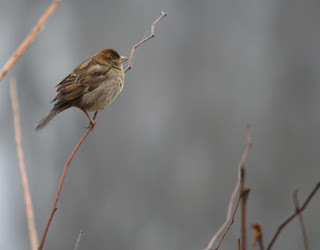 Female House Sparrow, Passer domesticus, well-chilled.
Female House Sparrow, Passer domesticus, well-chilled.Well, winter has finally caught up with us. Not musch in the way of snow, but bitterly cold. The prospect of picnics and out-door grilling is not as pleasing as it was a few months ago. Sparrows, cardinals, and chickadees are the only al fresco diners around here.
Every day, a neighbor’s cat sits patiently under the bird feeder, but—so far—there’s been no picnic lunch for him either.
Regular subscribers to our updates newsletter receive these updates from our blog, Just Served, directly—but there is much more at the blog that isn’t delivered automatically. “Doors,” a new year’s message that is sort of about food, appeared on there last month. “The Perception of Perception” also showed up on the blog (but it has absolutely nothing to do with food, so why should I even mention it?). We also posted “Rite of Passage,” a tale of lust (for food and other things), and “Gatherin’ Mequite” at Modern Salt.
You can, if you wish, follow us on Facebook, and Twitter. Still more of our online scribbles can be found at A Quiet Little Table in the Corner.
We’ll take what comfort we can from this month’s quotes (from On the Table’s culinary quote collection):
No dish changes quite so much from season to season as soup. Summer's soups come chilled, in pastel colors strewn with herbs. If hot they are sheer insubstantial broths afloat with seafood. In winter they turn steaming and thick to serve with slabs of rustic, crusty bread. Florence Fabricant
The height of luxury was reached in the winter afternoons … lying in a tin bath in front of a coal fire, drinking tea, and eating well-buttered crumpets is an experience few can have today. J.C. Masterman
When the girl returned, some hours later, she carried a tray, with a cup of fragrant tea steaming on it; and a plate piled up with very hot buttered toast, cut thick, very brown on both sides, with the butter running through the holes in it in great golden drops, like honey from the honeycomb. The smell of that buttered toast simply talked to Toad, and with no uncertain voice; talked of warm kitchens, of breakfasts on bright frosty mornings, of cosy parlour firesides on winter evenings, when one's ramble was over and slippered feet were propped on the fender, of the purring of contented cats, and the twitter of sleepy canaries. Kenneth GrahameGaryFebruary, 2016
PS: If you encounter broken links, changed URLs—or know of wonderful sites we‘ve missed—please drop us a line. It helps to keep this resource as useful as possible for all of us. To those of you who have introduced us to sites like the ones in this newsletter (such as Dianne Jacob and Jonell Galloway), thanks, and keep them coming!
PPS: If you wish to change the e-mail address at which you receive these newsletters, or otherwise modify the way you receive our postings or—if you’ve received this newsletter by mistake, and/or don‘t wish to receive future issues—you have our sincere apology and can have your e-mail address deleted from the list immediately. We‘re happy (and continuously amazed) that so few people have decided to leave the list but, should you choose to be one of them, let us know and we‘ll see that your in-box is never afflicted by these updates again. You’ll find links at the bottom of this page to fix everything to your liking.
---- the new sites ----
AJEats
(Al Jazeera’s food section)
Bacon Goes Kosher
(Erik Ofgang, in Tablet, on treyf-less strips of crisp-fried non-pork)
Cleaver Quarterly, The
(magazine about Chinese food)
Cooking with Pulses
(recipes and nutritional info from the USA Dry Pea & Lentil Council)
Medieval Mulled Wine
(Karen Schousboe, at Medieval Histories, traces the spiced libation from Apicius to today)
Michael Pollan on how America got so Screwed Up about Food
(hint: it’s the bizarre intersection of science, industry, and politics)
Noble Idea, A: Beer Without Hops
(James Sheehan, at Molotov Cocktail, on ancient beer styles that incorporated other botanical bittering agents)
Note on Peppers, A
(Hari Balasubramanian on peppers, Piper spp; and peppers, Capsicum spp.)
Problem of the House, The: Past, Present and Future
(Jack Self, in The Architectural Review, looks at kitchen design from several theoretical vantage points)
Sacred Khao
(an introduction to the foods of northern Thailand)
Science of Craving, The
(Amy Fleming, in The Economist, on the difference between desire and pleasure)
What is Bourgeois Cuisine?
(Jonell Galloway on the history of French cooking that is not so haute)
Why (Almost) Everything You Know About Food Is Wrong
(Julia Belluz analyzes the difficulty of getting accurate nutritional information)
---- inspirational (or otherwise useful) site for writers/bloggers ----
7 Book Marketing Trends Authors Can’t Afford to Ignore
10 Things We’ve Learned From Writing Cookbooks
Culinary Memoirs: What’s the Point?
How Do I Become a Food Writer?
How (Not) to Pitch
mdWordsmith
New York Public Library Makes 180,000 High-Res Images Available Online
On All the Ways to Write a Recipe
Restaurant Critic: Your Dream Job or Your Worst Nightmare?
Understanding Your Type as a Food Writer
Who Buys Cookbooks and Why?
Why Is It So Hard to Make Great Food Infographics?
---- more blogs ----
Erica Demane
Food Politics
Silphium
---- that’s all for now ----
Except, of course, for the usual legalistic mumbo-jumbo and commercial flim-flam:
Your privacy is important to us. We will not give, sell or share your e-mail address with anyone, for any purpose—ever. Nonetheless, we will expose you to the following irredeemably brazen plugs:
Want to support On the Table, without spending a dime of your own money on it?
It’s easy. Whenever you want to shop on Amazon. Com, click on any of the book links below, then whatever you buy there will earn a commission for this newsletter (it doesn’t even have to be one of our books).
The Resource Guide for Food Writers (Paper)(Kindle)
The Herbalist in the Kitchen(Hardcover)(Kindle)
The Business of Food: Encyclopedia of the Food And Drink Industries(Hardcover)(Kindle)
Human Cuisine(Paper)(Kindle)
Herbs: A Global History(Hardcover)(Kindle)
Sausage: A Global History(Hardcover)(Kindle)
Can It! The Perils and Pleasures of Preserving Foods (pre-order)(Hardcover)
Terms of Vegery(Kindle)
How to Serve Man: On Cannibalism, Sex, Sacrifice, & the Nature of Eating(Kindle)
Here endeth the sales pitch(es)...
...for the moment, anyway.
______________
The Resource Guide for Food Writers, Update #184 is protected by copyright, and is provided at no cost, for your personal use only. It may not be copied or retransmitted unless this notice remains affixed. Any other form of republication—unless with the author‘s prior written permission—is strictly prohibited.
Copyright (c) 2016 by Gary Allen.
Published on January 20, 2016 11:41
January 2, 2016
Doors

Janus—for whom our month of January is named—was a two-faced God who faced both forwards and backwards. Roman households often placed an image of Janus beside doorways. New Year’s Day is just such a doorway, and as we pass through it we often reflect on the past while speculating about the future.
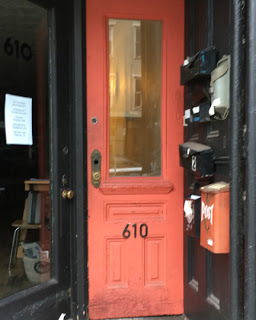
After rising at a prudently late hour (considering the excesses of the night before), Markus, Betsy, Karen, and I decided that it was fit and proper that we go on a used-book hunt. You should understand that we never need much of an excuse, but why not invoke the holiday spirit? So, the Four Bibliophiles of the Apocalypse sped from the Valley of the Hudson to the Hills of the Berkshires. I don’t need to tell you that we found—and purchased—bulging cartons of wondrous things. We always do.

Book-hunting is intense, and it provokes an equally intense thirst and hunger—so we headed for Hudson, NY, where we knew good restaurants existed in pleasing numbers. Hudson, not coincidentally, also has a lovely used book store. We chose a restaurant in which we’ve eaten many times, and ordered a variety of soups, appetizers, and desserts that we could share.

Markus and I ate savory slices of chorizo, rolled into tortillas, smeared with guacamole, and festooned with jalapeños. Completely satisfied, we went out into the night and started for home with our treasures.
A little way out of town, on one of the winter’s darkest nights, I suddenly realized that New Year’s Day was over—and that we had not eaten Hoppin’ John. This is an election year, and a slip-up like that could deprive us of not just one year without luck, but perhaps four grim years. Markus exclaimed that he, too, was risking bad luck by imprudently ignoring his family's traditional herring and lentils on this most important of days.

Of course, we don’t really believe in all this hocus pocus—but flauting tradition can’t be good, can it?

Sometime around five AM, on January second, we—at least Markus and I—learned the cost of our hubris. Unmistakable signs of food poisoning racked our bodies. Karen and Betsy were unscathed. We can’t be sure it was the chorizo, or the fact that Karen and Betsy were never as committed to the New Year’s Day rituals as we were, so were not judged as harshly.
We do know that there is one door in Hudson that we will not pass through again.

Published on January 02, 2016 15:37
December 31, 2015
The Perception of Perception
Waking in the morning: my eyes are not yet opened, but sounds arrive, unbidden. A distant sound, barely perceptible at first, draws my attention, and I fix my ears’ powers upon it, they go out to it, probing, turning up the volume on just it, and ignoring every other ambient sound. Ahhh… it’s just a squirrel trying, without success, to get into the bird feeder. The ears snap back onto the side of my head, and the sound’s volume drops to irrelevancy.One eyelid lifts reluctantly, allowing light to stream in, and slams shut. I open both eyes. At once, my senses stop being passive receivers of messages from the parts of the universe that aren’t me. My eyes stop being mere recipients of reflected light waves. They flit about the room, going out to caress and minutely examine tiny bumps on the ceiling, a spot of dappled light on the dresser. They do not idly collect visual data that just happens to be flowing toward them. They actively seine it in, picking through it for meaningful details. They ignore everything that is routine, ordinary. It’s as if only the noteworthy bits are even visible. Eyes can’t be bothered with what they’ve seen a million times before.Scientists tell us that none of this is actually happening. They say our senses merely respond to stimuli that surround me, but that’s not at all what it seems like.
I never feel like a passive receiver. Rather, I am an all-powerful omniscient observer, situated at the exact center of the Universe. Attuned to its slightest variations, I am able to reach out and extract their meaning, instantly. A telescope, microscope, and microphone are merely extensions of my senses—and, like them, flow out of me to collect whatever data I require.
I never feel like a passive receiver. Rather, I am an all-powerful omniscient observer, situated at the exact center of the Universe. Attuned to its slightest variations, I am able to reach out and extract their meaning, instantly. A telescope, microscope, and microphone are merely extensions of my senses—and, like them, flow out of me to collect whatever data I require.
Published on December 31, 2015 23:16
December 13, 2015
Food Sites for January 2016
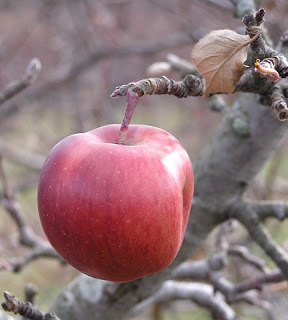
A lone winter apple, a treat for gleaning birds.
January is about beginning anew, returning to fundamentals, enjoying simple things after all the holiday excesses. What could be more basic than apple pie? After all, don’t we begin the alphabet with “A is for Apple?” Byron clearly associated the fruit with beginnings: “Since Eve ate apples...”
Last month we posted a couple of new articles. Roll Magazine published “Moors and Christians: Comfort Food for an Uncomfortable Season,” on serving the musical fruit, indoors. “Remembrance of Shellfish Past,” a travel reminiscence of sorts, appeared in Modern Salt.
We also completed the index and final edits to our latest book ( Can It! The Perils and Pleasures of Preserving Foods ), due for publication in May. WHEW!
Regular subscribers to our updates newsletter receive these updates from our blog, Just Served, directly—but there is much more at the blog that isn’t delivered automatically. You can, if you wish, follow us on Facebook, and Twitter. Still more of our online scribbles can be found at A Quiet Little Table in the Corner.
This month’s quotes (from On the Table’s culinary quote collection) are—quelle surprise!—about baked apples:
“I know the look of an apple that is roasting and sizzling on the hearth on a winter’s evening, and I know the comfort that comes of eating it hot, along with some sugar and a drench of cream... I know how the nuts taken in conjunction with winter apples, cider, and doughnuts, make old people’s tales and old jokes sound fresh and crisp and enchanting.” Mark Twain
“Good apple pies are a considerable part of our domestic happiness.” Jane Austen
“If you want to make an apple pie from scratch, you must first create the universe.” Carl SaganGaryJanuary, 2016
PS: If you encounter broken links, changed URLs—or know of wonderful sites we’ve missed—please drop us a line. It helps to keep this resource as useful as possible for all of us. To those of you who have introduced us to sites like the ones in this newsletter (such as Krishnendu Ray), thanks, and keep them coming!
PPS: If you wish to change the e-mail address at which you receive these newsletters, or otherwise modify the way you receive our postings or—if you’ve received this newsletter by mistake, and/or don’t wish to receive future issues—you have our sincere apology and can have your e-mail address deleted from the list immediately. We’re happy (and continuously amazed) that so few people have decided to leave the list but, should you choose to be one of them, let us know and we’ll see that your in-box is never afflicted by these updates again. You’ll find links at the bottom of this page to fix everything to your liking.
---- the new sites ----
Chinese Food and the Joy of Inauthentic Cooking(Hua Hsu in the New Yorker)
CIA Menu Collection(from the archives of The Culinary Institute of America)
Cocktail at the End of the Universe, The(visiting nerd bars, “in search of the Pan-Galactic Gargle Blaster, an imaginary 1970’s cocktail from space”)
End of Craft Beer, The(Matthew Giles, at Grub Street, on the current—and future—state of “artisanal-small-independent” breweries)
How Horror Star Vincent Price Eerily Predicted America’s Culinary Future(a movie star’s travel/cook book pre-dated Time-Life’s Foods of the World series by three years, making ordinary Americans’ culinary options less provincial)
How the Western Diet Has Derailed Our Evolution(Moises Velasquez-Manoff, writing in Nautilus, on what microbiologists are beginning to learn about the friendly “germs” that should be living in our guts—and what happens when they aren’t)
Modern Salt (lovely new magazine from Great Britain, but featuring food writers from all over; mostly online, with occasional printed editions planned)
Sex, Death and Mushrooms(Helen MacDonald, in The New York Times, on foraging for fungi in the English countryside)
Spice That Built Venice, The(Jack Turner, at Smithsonian, on the medieval pepper trade)
Taste, Toil and Ethnicity(Krishnendu Ray, at Huffpost, on the relationship between the food industry’s largely immigrant workforce and changing mainstream attitudes about “taste”)
Unusual Coleslaw(recipes from South Australian community cookbooks)
What to Eat in France: The History of Sauce(an excerpt from a book-in-progress by Jonell Galloway)
Who Owns Southern Food?(Andrea King Collier—at National Geographic’s blog, The Plate—hopes to “...begin a real conversation about race, culture and food in this country...”)
Why We Took Cocaine Out of Soda(short answer: racism)
---- inspirational (or otherwise useful) site for writers/bloggers ----
3 Reasons Why Great Writers Always Work Alone
Case of the Disappearing Editor, The
Dear Authors, I’m Sorry
Freelance Isn’t Free!
How to Build an Author Platform Through Email Lists
How to Start a Food Blog: The Ultimate Step-by-Step Guide
Importance of Feedback, The
Lost Art of Letter-Writing, The
Self-Editing Basics: 10 Simple Ways to Edit Your Own Book
Twitter Tips for Authors
Watch What Happens When You Ask Non-Creative Professionals to Work for Free
What Does a Literary Agent Want to See When They Google You?
Writers, We Need to Stop Saying This
You Elitist, Supercilious, Condescending, Snob!
---- more blogs ----
Becky Diamond
Culinaria Eugenius
Little Library Café, The
---- changed URL ----
Pass the Garum
---- that’s all for now ----
Except, of course, for the usual legalistic mumbo-jumbo and commercial flim-flam:
Your privacy is important to us. We will not give, sell or share your e-mail address with anyone, for any purpose—ever. Nonetheless, we will expose you to the following irredeemably brazen plugs:
Want to support On the Table, without spending a dime of your own money on it?
It’s easy. Whenever you want to shop on Amazon (think last-minute holiday shopping), click on any of the book links below, then whatever you buy there will earn a commission for this newsletter (it doesn’t even have to be one of our books).
The Resource Guide for Food Writers
(Paper)(Kindle)
The Herbalist in the Kitchen
(Hardcover)
(Kindle)
The Business of Food: Encyclopedia of the Food And Drink Industries
(Hardcover)(Kindle)
Human Cuisine
(Paper)(Kindle)
Herbs: A Global History
(Hardcover)(Kindle)
Sausage: A Global History
(Hardcover)(Kindle)
Can It! The Perils and Pleasures of Preserving Foods (pre-order)(Hardcover)
Terms of Vegery
(Kindle)
How to Serve Man: On Cannibalism, Sex, Sacrifice, & the Nature of Eating
(Kindle)
Here endeth the sales pitch(es)...
...for the moment, anyway.
______________
“The Resource Guide for Food Writers, Update #183” is protected by copyright, and is provided at no cost, for your personal use only. It may not be copied or retransmitted unless this notice remains affixed. Any other form of republication—unless with the author‘s prior written permission—is strictly prohibited.
Copyright (c) 2016 by Gary Allen.
Published on December 13, 2015 09:43
November 20, 2015
The Bottom Line
I recently took a business class. I know—that seems completely out of character, but try to get past that for a moment.The instructor started by asking if any of the students had their own businesses. A couple of them did, and while I was tempted to join them, I held back. I suspected that they wouldn’t consider my writing to be a real business (even if the IRS does). The instructor asked each of the responding proprietors if they considered themselves to be successful. They did. He then followed up with questions that tried to better define their ideas of what constituted “success.” No matter how they responded, he managed to reduce the idea of success to just one aspect: increased revenue.I sat back in my chair, relieved to discover that resisting the opportunity to join in had been the right move. For one thing, reducing what I do, as a writer, to the accumulation of “increased revenue” would either be laughable or severely depressing. There was no way that the class, or its instructor, could possibly think that my “business” was successful. What could I possibly gain by exposing myself to such ridicule? And yet, I do consider my writing business to be successful. How would I have been able to explain that seeming incongruity?Perhaps (since I’m a writer) I might employ a metaphor. Consider two hypothetical travelers: both need to get from Point A to Point B. For one traveler, the destination is everything. Using the most efficient available means of transport makes sense for that traveler, because the trip is just an inconvenient delay that must be endured before arrival at Point B. Anything that renders the trip uneventful is preferred (because “events,” by their very nature, are distractions). We’ve seen many such travelers at airports; their tiny carry-ons allowing them to zip through TSA screening, and avoid needlessly waiting for luggage to arrive at their destination. They look straight ahead, as if their goal was almost visible, just over the horizon. If our first traveler does not reach Point B, then the trip is a failure.Our other hypothetical traveler also needs to get to Point B, but the destination isn’t the only consideration. Instead of flying from airports, all of which are as mind-deadeningly identical as a mall, this traveler prefers to take to the road. Cars, bicycles, or hiking boots are the preferred modes of transportation. This traveler’s eyes are on the horizon too, but also along both s ides of the road, into the woods, and up and down each river that is crossed. Whereas one traveler wishes to deny the existence of the distance between two points, the other want to experience every bit of it. For the second traveler, the trip is not an inconvenient delay in attaining the goal, it is part of the goal. If the second traveler doesn’t get to Point B, it would not be a failure, because the trip itself had provided rewards all along the way.Efficiency drives one traveler, experience drives the other. Rather than extend the metaphor far beyond its breaking point, let’s just agree that the point of most businesses is the acquisition of money—money that, presumably, can be used to pay for whatever makes the business owner happy. So, in a sense, the business itself is an inconvenience that stands between one and one’s goal.For me, every part of the writing process makes the trip worth it: the original concept, the research, the blocking out and subsequent re-arranging of the parts, the search for the right combination of words, the surprise when a near-synonym reveals additional unexpected insight, overcoming difficulties along the way, re-working the piece’s to clarify its argument, even the dialogue with readers who find unintended meanings I hadn’t known were there—both good and bad.
This writing “business” could, in theory, be used to fund some other desired reward—but that would just be an extra perk. Obviously, I prefer to be paid for my work but, even when I don’t get a check, the writing itself pays me. It all comes down to semantics and varying definitions of “business” and “success”—differences that would probably be nonsensical to the instructor and everyone else in that classroom.
Published on November 20, 2015 14:43
November 7, 2015
Food Sites for December 2015
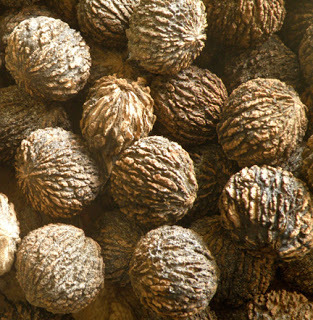
Uncracked (and virtually uncrackable) black walnuts, Juglans nigra
The holiday season looms before us, so this month’s issue is served early. It’s a big one, so we wanted to give you a chance to digest it before the serious eating and drinking begins.
Regular subscribers to our updates newsletter receive these updates from our blog, Just Served, directly—but there is much more at the blog that isn’t delivered automatically. Last month the blog featured an update on an article that had previously appeared in Roll Magazine. “Seeing Red Redux,” dishes H. Allen Smith’s literary trash talk concerning another’s pretence to chili greatness.
You can, if you wish, follow us on Facebook, and Twitter. Still more of our online scribbles can be found at A Quiet Little Table in the Corner.
This month’s quotes (from On the Table’s culinary quote collection) are hot stuff:
“It doesn’t matter who you are, or what you’ve done, or think you can do. There's a confrontation with destiny awaiting you. Somewhere, there is a chile you cannot eat.” Daniel Pinkwater
“Next to jazz music, there is nothing that lifts the spirit and strengthens the soul more than a good bowl of chili.” Harry James
“Chili represents your three stages of matter: solid, liquid, and eventually gas.” character Dan Conner, on Roseanne
“Wish I had time for just one more bowl of chili.” Kit Carson’s last wordsDecember, 2015
PS: If you encounter broken links, changed URLs—or know of wonderful sites we’ve missed—please drop us a line. It helps to keep this resource as useful as possible for all of us. To those of you who have introduced us to sites like the ones in this newsletter (such as Ken Albala), thanks, and keep them coming!
PPS: If you wish to change the e-mail address at which you receive these newsletters, or otherwise modify the way you receive our postings or—if you’ve received this newsletter by mistake, and/or don’t wish to receive future issues—you have our sincere apology and can have your e-mail address deleted from the list immediately. We’re happy (and continuously amazed) that so few people have decided to leave the list but, should you choose to be one of them, let us know and we’ll see that your in-box is never afflicted by these updates again. You’ll find links at the bottom of this page to fix everything to your liking.
---- the new sites ----
Accounting for Taste(The New Yorker’s Nicola Twilley on Charles Spence’s experiments using our other senses to change our perception of flavor)
Archive of Eating, The(a New York Times article, by Bee Wilson, about Barbara Ketcham Wheaton’s database of ancient recipes)
At the Getty Museum, Outrageous Menus of Centuries Past(Judith H. Dobrzynski, in The New York Times, on Getty’s exhibit, “The Edible Monument: The Art of Food for Festivals”)
Betty Crocker’s Absurd, Gorgeous Atomic-Age Creations(Tamar Adler, in The New York Times, on the politics and psychology behind all those dishes that seem ridiculous to us, now)
Chemistry Teacher’s Guide to the Perfect Cup of Coffee, A(The Guardian’s Andy Brunning has the jitters about bitterness)
Craft Beer Is Booming, but Some Brewers Worry About the Future(Vikas Bajaj, in The New York Times, is concerned about the effect mergers will have on distribution of artisanal brews)
Eat, Drink, and Be Merry: Food in the Middle Ages and Renaissance(an exhibit at the Getty Museum)
Endangered Apples: Help Save Britain’s Rare Varieties(The Guardian’s Felicity Cloake on ignored heirloom varieties)
Food Studies is Not as Frivolous as You Might Think(Kristin Reynolds and Julian Agyeman on societal benefits of food studies programs)
Gastronomy Books(selected rare books in the Library of Congress collection)
Guide to the Chilies of Mexico, The(Lucky Peach’s guide, by Alex Stupak & Jordana Rothman, authors of Tacos: Recipes and Provocations)
How and Why You Should be Making Blood Sausage at Home(Bryan Mayer celebrates his inner vampire at Food Republic)
In Defense of the True ’Cue(the gospel—of North Carolina BBQ—according to Calvin Trillin, in The New Yorker)
Is Wine Flavor in the Wine or in the Mind (Part 1)Is Wine Flavor in the Wine or in the Mind (Part 2)(Dwight Furrow’s efforts to separate the subjective from the objective in wine tasting)
Jewish Meals in Antiquity(Jordan D. Rosenblum draws upon archaeological and textual evidence)
Mark Twain–Recipes from a Little Bill of Fare(Tori Avey on Twain’s nostalgic longing for familiar American dishes while traveling in Europe)
Museum of Food and Drink Takes a Look at Flavor(William Grimes, in The New York Times, reports on an exhibit about flavor chemistry)
Neurogastronomy 101: The Science of Taste Perception(Eater’s Susmita Bara on the collaboration between chefs, food technologists, and scientists to better understand how we perceive taste, in order to improve our food, both aesthetically and nutritionally)
Pumpkins and Cabbages(vegetable puns and metaphors in Shakespeare’s The Merry Wives of Windsor)
Reconstructing Medieval Bread(Ken Albala digs through the archives of the J. Paul Getty Museum)
Sexism in the Kitchen(Jen Agg, in The New York Times, on the “testosterone-fueled environment” that continues to exist in professional kitchens)
Tasting a Flavor that Doesn’t Exist(Jenny Chen, in Atlantic, on how some aromas can make us perceive tastes, even when they missing)
To Help Feed Billions of People, Scientists Braved the Snake-Infested and Croc-Filled Swamps of Northern Australia in Search of Rice(Lisa M. Hamilton, in The California Sunday Magazine, on the perils of looking into the early history of Oryza sativa)
Uncovering the Myths of the “Founding Mother” Cuisine: A Few Words about England, Africa, and a Bibliography(southern cooking has been the darling of American food lately, which has led to much speculation about the role of African cooking in the creation of U.S. “cuisine;” Cynthia Bertelsen is trying to sort out the issues involved)
USDA Pomological Watercolor Collection(searchable database of 7584 images of fruits, created between 1886 and 1942)
What is Black Garlic?(Dr. Arielle Johnson tells what it is—and what it isn’t—at Lucky Peach)
You Asked: Should I Count Calories?(Markham Heid, in Time: not all calories are created equal)
---- inspirational (or otherwise useful) site for writers/bloggers ----
12 Struggles Only People Who Work from Home Truly Understand
British Library Offers Over 1 Million Free Vintage Images for Download
Is Your Food Blog Good Enough for a Beard Award?
Why I Write for Free
Why the Battle Between E-Books and Print May be Over
Why This Food Writer Refuses to Review Street Vendors
Your First Book is Finished and Published! Now What? (Do’s and Don’ts
---- more blogs ----
Art of Food
cooking with bruce and mark
---- that’s all for now ----
Except, of course, for the usual legalistic mumbo-jumbo and commercial flim-flam:
Your privacy is important to us. We will not give, sell or share your e-mail address with anyone, for any purpose—ever. Nonetheless, we will expose you to the following irredeemably brazen plugs:
Want to support On the Table, without spending a dime of your own money on it?
It’s easy. Whenever you want to shop on Amazon. Com, click on any of the book links below, then whatever you buy there will earn a commission for this newsletter (it doesn’t even have to be one of our books).
The Resource Guide for Food Writers
(Paper)(Kindle)
The Herbalist in the Kitchen
(Hardcover)
(Kindle)
The Business of Food: Encyclopedia of the Food And Drink Industries
(Hardcover)(Kindle)
Human Cuisine
(Paper)(Kindle)
Herbs: A Global History
(Hardcover)(Kindle)
Sausage: A Global History
(Hardcover)(Kindle)
Can It! The Perils and Pleasures of Preserving Foods (pre-order)(Hardcover)
Terms of Vegery
(Kindle)
How to Serve Man: On Cannibalism, Sex, Sacrifice, & the Nature of Eating
(Kindle)
Here endeth the sales pitch(es)...
...for the moment, anyway.
______________
The Resource Guide for Food Writers, Update #182 is protected by copyright, and is provided at no cost, for your personal use only. It may not be copied or retransmitted unless this notice remains affixed. Any other form of republication—unless with the author'‘s prior written permission—is strictly prohibited.
Copyright (c) 2015 by Gary Allen.
Published on November 07, 2015 09:03
October 26, 2015
Seeing Red Redux
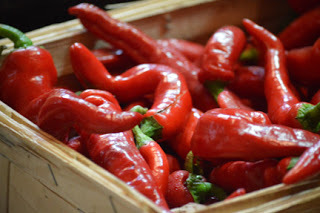
We’ve written elsewhere about how varying opinions concerning the hows, what-nots, why-nots, and wherefores of chili con carne have led to some—what’s a polite way to describe it—intense ego-driven battles. In case you missed that column—or are too damned lazy to follow the link—allow me provide some background. I’ll see your laziness and raise you this (not coincidently saving me the trouble of writing it anew):In 1967, a humorist named H. Allen Smith—who lived in (of all places) New York's Westchester County—published an article in Holiday magazine, in which he puffed up his chest and bragged, “Nobody knows more about chili than I do.” As you might imagine, many chili aficionados, some of them native Texans, took wholly justified umbrage with that Yankee disrespect.One irate Texan, Frank X. Tolbert, had recently published the very first book about chili: A Bowl of Red . Tolbert was a popular columnist at the Dallas Morning News. A reader of his “Tolbert’s Texas” column protested that no self-respecting Texan should ever allow an insult of that magnitude to stand unchallenged. He urged Tolbert’s friend Wick Fowler -- creator of Wick's Two-Alarm Chili mix -- to defend the Lone Star State against this revival of the War of Northern Aggression. The resulting show-down (that – surely a mere coincidence -- served as a promotional stunt for A Bowl of Red) was the world's first Chili Cook-Off. Some 250 people showed up to watch the two-man firefight in the small, but dusty, town of Terlingua. Smith made the classic mistake of bringing a ladle to a gunfight. Fowler, with characteristically understated Texan savoir faire, competed in the shade of an immense sombrero. Everyone expected the locale to have given the home-field advantage to Fowler. However, when the dust (and/or flatulence) cleared, the result was a draw.We’ve since learned that the Smith/Fowler pot was stirred by more than Smith’s first chili boast. About the same time as Smith waved his red cape in Fowler’s face, he also wrote a book, a book that, we are led to believe, was not about chili at all. It was about a cat.Much like this article, Smith’s book was a sequel. His earlier book, Rhubarb (1946), was about a wild and cantankerous feline that managed to inherit a huge fortune from an equally cantankerous benefactor. Part of the cat’s inheritance, and the bulk of the story, was a losing New York baseball that was affectionately known to its fans as “The Loonies.” The cat, of course, turned the team into a winner.But we digress.Smith’s sequel, Son of Rhubarb , came out in 1967. The fact that it was published in the same year as his Holiday article—and in the year following the publication of Fowler’s A Bowl of Red, might just seem to be a coincidence. Unless we read it.The book opens with the demise of Rhubarb, followed immediately by the scramble of all sorts of unscrupulous individuals for the cat’s millions—all of whom are glad that there was no heir. Unless there was one…The rest of the book involves the search for that heir, and—lest you think that this digression has gone on too long, and that we’ve lost the thread completely—takes us from New York to…Wait for it…Texas.And not just any part of Texas, but a ranch called Bowlared, owned by someone named Petticoats Kockamaney (who, like Fowler, had made his fortune selling chili powder). Kockamaney’s was not just any chili powder,; it was made of a secret blend of spices that acted like Viagra on those who ate it. This was a nod to an old O. Henry story, “The Enchanted Kiss,” which—not coincidentally—was the first literary mention of chili con carne. In the O. Henry story, Mexican women, called “chili queens,” purveyed their bowls of red on the darkened Military Plaza of San Antonio. Their fragrant dishes gave one certain life-affirming powers—but only if prepared with one very unusual ingredient. Kockamaney’s chili powder also had a special ingredient, but we’ll keep both secrets (so as not to spoil the surprises). Kockamaney protected his secret recipe, and secret stash, with the help of a small army of former Hell’s Angels he called his “Chili Queens,” who—despite their collective name—are “no more’n thirty-three and a third per cent” queer. This was, you understand, 1967, when “queer” was still used as a pejorative; hell, it might still be, in Good Ol’ Boy Texas.Just to make sure we readers know who was doing the boasting and cow-pie tossing, Smith frequently appeared in his own book, portrayed as an incredibly suave, handsome, and omnipotent savior, who showed up—miraculously—whenever he was most needed.We never get to see the white hat Smith must have been wearing (or his smirk, thinking about Fowler’s reaction to the book).ReferencesSmith, H. Allen. “Nobody Knows More About Chili Than I Do.” Holiday 42:68-9, August 1967.
Rhubarb, Country Life Press: New York, 1946.
Son of Rhubarb. New York: Trident Press, 1967
Tolbert, Frank X. A Bowl of Red. Garden City, NY: Doubleday, 1966.
Published on October 26, 2015 16:02
October 19, 2015
Food Sites for November 2015
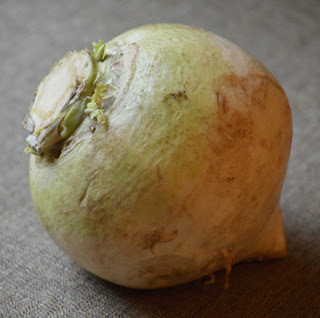
Cape Cod White (or Eastham) Turnip.
Since Thanksgiving is soon to be upon many of us in the food blogging community, we thought we should share this.
You know, for perspective.
Since our latest book, Sausage: A Global History, was finally released, we published a couple of utterly self-serving articles in support of it: “Prepare Yourself for the Wurst,” and “Not Really a Book Review,” both at Roll Magazine.
Our next book, Can It! The Pleasures and Perils of Preserving Foods, is already edited and in production. It should be out in 2016.
Regular subscribers to our updates newsletter receive these updates from our blog, Just Served, directly—but there is much more at the blog that isn’t delivered automatically. Last month, for example, the blog featured a guest post by Joel Denker: The Carrot Quest. It’s adapted from the Introduction to his new book, The Carrot Purple and Other Curious Stories of the Food We Eat .
You can, if you wish, follow us on Facebook, and Twitter. Still more of our online scribbles can be found at A Quiet Little Table in the Corner.
This month’s quotes (from On the Table’s culinary quote collection) is utterly and unapologetically arbitrary:
“…whether we are conspicuously eating well, or conspicuously depriving ourselves and others, we mark ourselves off—either as having more than anyone else, or less; and either is made a virtue...” Robin Fox
“Food writing shouldn’t be precious, pretentious, or condescending. Just because you know what confit means doesn’t make you a better person.” Adam Roberts
“Sometimes I think I’m liquefying like an old Camembert.” Gustave Flaubert
“Pythagoras might have [had] calmer sleeps, if he [had] totally abstained from beans.” Sir Thomas Browne
GaryNovember, 2015
PS: If you encounter broken links, changed URLs—or know of wonderful sites we’ve missed—please drop us a line. It helps to keep this resource as useful as possible for all of us. To those of you who have introduced us to sites like the ones in this newsletter (such as Fabio Parasecoli), thanks, and keep them coming!
PPS: If you wish to change the e-mail address at which you receive these newsletters, or otherwise modify the way you receive our postings or—if you’ve received this newsletter by mistake, and/or don’t wish to receive future issues—you have our sincere apology and can have your e-mail address deleted from the list immediately. We’re happy (and continuously amazed) that so few people have decided to leave the list but, should you choose to be one of them, let us know and we’ll see that your in-box is never afflicted by these updates again. You’ll find links at the bottom of this page to fix everything to your liking.
---- the new sites ----
12 Food Idioms in Other Languages(tasty tidbits from Oxford Dictionaries)
Carbon Footprint of Eating Out, The(Chris Ying compares, at Lucky Peach, the environmental impact of eating in restaurants vs. home-cooked meals)
Diaspora of Spam, The(Evelyn Kim, a guest curator at The New York Academy of Medicine, on the all-too-familiar brick of meat in a can)
Diet Fads are Destroying Us: Paleo, Gluten-Free and the Lies We Tell Ourselves(an interview—with Alan Levinovitz, in Salon—on the purpose and function of popular food choices, disguised as science, that are actually irrational)
Economic History of Leftovers, An(Atlantic’s Helen Veit plots the rise and fall—and rise—of popularity of recycled meals against changes in technology, economy, and environmental awareness)
For Decades, the Government Steered Millions Away from Whole Milk. Was that Wrong?(Peter Whoriskey questions official dogma in The Washington Post—bring on the butterfat!)
Fried Eggs with Jam? A Short History of the USSR Through its Food(An excerpt from The CCCP Cook Book: True Stories of Soviet Cuisine, by Olga Syutkin and Pavel Syutkin)
History of Poland’s National Obsession with Open Sandwiches, A(Magdalena Kasprzyk–Chevriaux, on the transition from French hors d'oeuvres to Polish everyday food)
How Early Cookbooks Sparked a Lifestyle Revolution(how Platina—and printing—changed everything; Christine Baumgarthuber explains in The New Inquiry)
Is “Food Porn” Making Us Fat?(Trevor Baker looks at new scientific evidence, in The Guardian, that casts blame for obesity on—wait for it—food writers & photographers)
Modern Cooking & the Erice Workshops on Molecular & Physical Gastronomy (Harold McGee on the origins of so-called “molecular gastronomy”)
Mushroom that Explains the World, The(Jedediah Purdy’s review of Anna Lowenhaupt Tsing’s The Mushroom at the End of the World in New Republic; fungi as metaphor for an economics of decay)
Photogrammar(searchable database of 170,000 WPA-era photos taken between 1935 and 1945, almost all public domain)
Send a Salami to Your Boy in the Army(an excerpt from Ted Merwin’s book, Pastrami on Rye: An Overstuffed History of the Jewish Deli )
Sexism of American Kitchen Design, The(Rachel Z. Arndt, in The Atlantic, on the causes and effects of standardization)
Snobs, Critics, and Wine Lovers(Dwight Furrow: “…wine lovers seek experience, wine snobs seek approval”)
Way to Kill a Complex City is to Chase Out All the Poor People—and Their Food, The(Samantha Gillison’s lament over lost luncheonettes and the glories of a simpler—and cheaper—past, in The Guardian)
What do Real Italians think about New York’s Italian Food?(Rose Hackman, in The Guardian, finds much of it pretty hard to swallow)
What Ever Happened to Turtle Soup?(Jack Hitt’s article, in Saveur, about an old-time classic that is now nearly forgotten)
When Food Changed History: The French Revolution(Lisa Bramen, about two simultaneous revolutions, in The Smithsonian)
---- inspirational (or otherwise useful) site for writers/bloggers ----
30 Food Photography Tips for Bloggers: The Ultimate Guide
Why Have Digital Books Stopped Evolving?
Written Recipes Undergo a Makeover
---- that’s all for now ----
Except, of course, for the usual legalistic mumbo-jumbo and commercial flim-flam:
Your privacy is important to us. We will not give, sell or share your e-mail address with anyone, for any purpose—ever. Nonetheless, we will expose you to the following irredeemably brazen plugs:
Want to support On the Table, without spending a dime of your own money on it?
It’s easy. Whenever you want to shop on Amazon. Com, click on any of the book links below, then whatever you buy there will earn a commission for this newsletter (it doesn’t even have to be one of our books).
The Resource Guide for Food Writers
(Paper)(Kindle)
The Herbalist in the Kitchen
(Hardcover)
(Kindle)
The Business of Food: Encyclopedia of the Food And Drink Industries
(Hardcover)(Kindle)
Human Cuisine
(Paper)(Kindle)
Herbs: A Global History
(Hardcover)(Kindle)
Sausage: A Global History
(Hardcover)(Kindle)
Terms of Vegery
(Kindle)
How to Serve Man: On Cannibalism, Sex, Sacrifice, & the Nature of Eating
(Kindle)
Here endeth the sales pitch(es)...
...for the moment, anyway.
______________
“The Resource Guide for Food Writers, Update #181” is protected by copyright, and is provided at no cost, for your personal use only. It may not be copied or retransmitted unless this notice remains affixed. Any other form of republication—unless with the author’s prior written permission—is strictly prohibited.
Copyright (c) 2015 by Gary Allen.
Published on October 19, 2015 11:30
October 9, 2015
Neon

Around nineteen-sixty-one or two, I showed one of my poems (I was very young, and still wrote poetry) to Mr. Grant, a favorite teacher—a man who mentored me long after I had been just one of his many pupils. He was, himself, a poet, and I respected his opinion over all others.I no longer remember much about the poem, but I recall that I had used “neon” as a metaphor for something ineffably beautiful. I was stunned when he told me I needed to change that specific word. He said it was wrong, that it sent the wrong message because it had such negative connotations. At the time I couldn’t understand his objection.For me, “neon” suggested glowing brilliance, the sort of thing that turns urban wet pavements, at night, into magical vistas, replacing the mundane horizontality of the daytime world into a maelstrom of swirling color, one that is limited by neither top nor bottom, but simply is, in omnipresent glory. For him, the word had only one meaning: “tawdry.”I know, now, why he felt that way: he grew up in a different time, in a different cultural context. Our conversation was an example of generational language differences. Imagine a confrontation between a painter of the Ashcan School and a Pop artist. Both look at the ordinary world, and portray it as they see it—but they see it through very different eyes. One wants to reveal the squalor of ordinary life, while the other celebrates the sheer exuberance of it. Both, in effect, preach to the art-buying intelligentsia, the sort of people who don’t live in anything like the worlds they paint—but their sermons couldn’t be more different. Warhol might understand the Glackens' point-of-view—intellectually, if not viscerally—but Glackens would be mystified by Warhol.Jacob Riis spoke to one generation, Tom Wolfe to the other. The city of one smelled of stale cabbage and trash, the other of incense and hashish.I was still writing in the JFK era—before my generation had found its modus operandi—but the language we would eventually need was already evolving. Before the decade was out “neon,” and all it implied to the adolescent me, would epitomize the very spirit of the psychedelic generation.I hadn’t understood Mr. Grant’s objection because I didn’t realize that we weren’t speaking the same language. Dylan had not yet written “The Times They Are a-Changin’,” but they already were. Will this be a lesson we will apply in trying to communicate with the next generations?It seems unlikely.
Published on October 09, 2015 07:47



